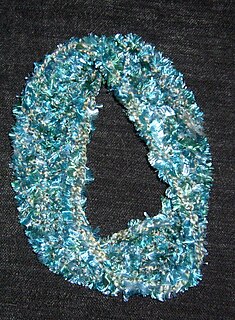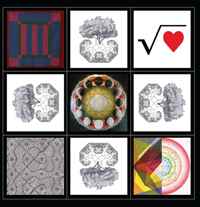 W
WMathematics and art are related in a variety of ways. Mathematics has itself been described as an art motivated by beauty. Mathematics can be discerned in arts such as music, dance, painting, architecture, sculpture, and textiles. This article focuses, however, on mathematics in the visual arts.
 W
WAnamorphosis is a distorted projection requiring the viewer to occupy a specific vantage point, use special devices or both to view a recognizable image. Some of the media it is used in are painting, photography, sculpture and installation, toys, and film special effects. The word "anamorphosis" is derived from the Greek prefix ana‑, meaning "back" or "again", and the word morphe, meaning "shape" or "form". An oblique anamorphism is the visualization of a mathematical operation called an affine transformation. The process of extreme anamorphosis has been used by artists to disguise caricatures, erotic and scatological scenes, and other furtive images from a casual viewer, while revealing an undistorted image to the knowledgeable spectator.
 W
WNew possibilities opened up by the concept of four-dimensional space helped inspire many modern artists in the first half of the twentieth century. Early Cubists, Surrealists, Futurists, and abstract artists took ideas from higher-dimensional mathematics and used them to radically advance their work.
 W
WMaking Mathematics with Needlework: Ten Papers and Ten Projects is an edited volume on mathematics and fiber arts. It was edited by sarah-marie belcastro and Carolyn Yackel, and published in 2008 by A K Peters, based on a meeting held in 2005 in Atlanta by the American Mathematical Society.
 W
WMathematical beauty is the aesthetic pleasure typically derived from the abstractness, purity, simplicity, depth or orderliness of mathematics. Mathematicians often express this pleasure by describing mathematics as beautiful. They might also describe mathematics as an art form or, at a minimum, as a creative activity. Comparisons are often made with music and poetry.
 W
WA mathematical sculpture is a sculpture which uses mathematics as an essential conception. Helaman Ferguson, George W. Hart, Bathsheba Grossman, Peter Forakis and Jacobus Verhoeff are well-known mathematical sculptors.
 W
WIdeas from Mathematics have been used as inspiration for fiber arts including quilt making, knitting, cross-stitch, crochet, embroidery and weaving. A wide range of mathematical concepts have been used as inspiration including topology, graph theory, number theory and algebra. Some techniques such as counted-thread embroidery are naturally geometrical; other kinds of textile provide a ready means for the colorful physical expression of mathematical concepts.
 W
WMughal architecture is the type of Indo-Islamic architecture developed by the Mughals in the 16th, 17th and 18th centuries throughout the ever-changing extent of their empire in the Indian subcontinent. It developed the styles of earlier Muslim dynasties in India as an amalgam of Islamic, Persian, Turkic and Indian architecture. Mughal buildings have a uniform pattern of structure and character, including large bulbous domes, slender minarets at the corners, massive halls, large vaulted gateways, and delicate ornamentation; Examples of the style can be found in modern-day India, Afghanistan, Bangladesh, and Pakistan.
 W
WMusic theory has no axiomatic foundation in modern mathematics, although some interesting work has recently been done in this direction, yet the basis of musical sound can be described mathematically and exhibits "a remarkable array of number properties". Elements of music such as its form, rhythm and metre, the pitches of its notes and the tempo of its pulse can be related to the measurement of time and frequency, offering ready analogies in geometry. Moreover, "mathematics offers a reliable tool to answer questions on musical elements, such as for instance and above all the basic issues of properly defining, counting and eventually order them under meaningful principles. Its capabilities as a unique tool for deepening and understanding the underlying structures of several musical elements and techniques have been then proven by the numerous results achieved in the mathemusical literature. Therefore, mathematics and mathemusical theory are a valuable option for gaining musical knowledge. However, they are not only a tool for taxonomical discoveries. The meticulous study of the mathematical structures and combinatorial mechanisms that a specific set of musical objects hides let unlock differently hidden features of its expressive potential. It is a framework for potential artistic discoveries".
A New Kind of Science is a book by Stephen Wolfram, published by his company Wolfram Research under the imprint Wolfram Media in 2002. It contains an empirical and systematic study of computational systems such as cellular automata. Wolfram calls these systems simple programs and argues that the scientific philosophy and methods appropriate for the study of simple programs are relevant to other fields of science.
 W
WThe NinKi: Urgency of Proximate Drawing Photograph (NinKi:UoPDP) was initiated by Bangladeshi visual artist Firoz Mahmud. This is a drawing photograph project to rhetorically rescue popular icons with geometric structure drawings or make photo image of the people tactically static. His pigeonhole or kind of compartmental examples of doodling were engaged on found images in various printed media and also were found in his sketchbook, books, notebooks and often in his borrowed books. The word 'Ninki' (人気) is a Japanese word which means be Popular or popularity. The Ninki: UoPDP art Project of drawing on photographs consist of numerous archetypal images of popular celebrities in vague appearance. Their career, character, fame, obscurity, activities and character are insurgent and idiosyncratic. Artist Firoz has started on any image and then specifically on Bengal tiger and more significantly on Japanese Sumo Wrestler as artist based in Japan and fascinated by sports, media and interested on humorous aspect of entertainment industries.
 W
WA Penrose tiling is an example of an aperiodic tiling. Here, a tiling is a covering of the plane by non-overlapping polygons or other shapes, and aperiodic means that shifting any tiling with these shapes by any finite distance, without rotation, cannot produce the same tiling. However, despite their lack of translational symmetry, Penrose tilings may have both reflection symmetry and fivefold rotational symmetry. Penrose tilings are named after mathematician and physicist Roger Penrose, who investigated them in the 1970s.
 W
WRhythm of Structure is a multimedia interdisciplinary project founded in 2003. It features a series of exhibitions, performances, and academic projects that explore the interconnecting structures and process of mathematics and art, and language, as way to advance a movement of mathematical expression across the arts, across creative collaborative communities celebrating the rhythm and patterns of both ideas of the mind and the physical reality of nature.
 W
WThe Basílica de la Sagrada Família, also known as the Sagrada Família, is a large unfinished Roman Catholic minor basilica in the Eixample district of Barcelona, Catalonia, Spain. Designed by Spanish/Catalan architect Antoni Gaudí (1852–1926), his work on the building is part of a UNESCO World Heritage Site. On 7 November 2010, Pope Benedict XVI consecrated the church and proclaimed it a minor basilica.
 W
WThe Sydney Opera House is a multi-venue performing arts centre at Sydney Harbour located in Sydney, New South Wales, Australia. It is one of the 20th century's most famous and distinctive buildings.